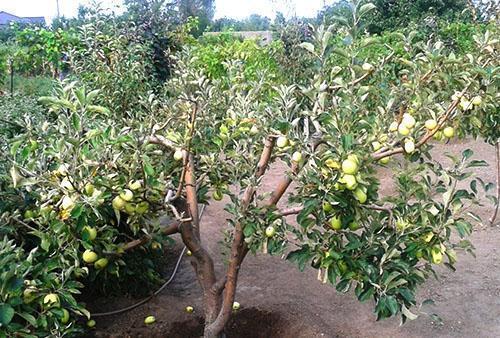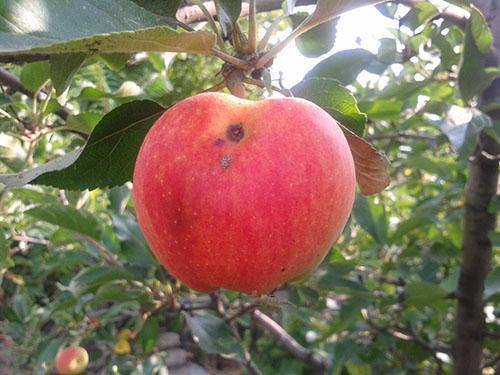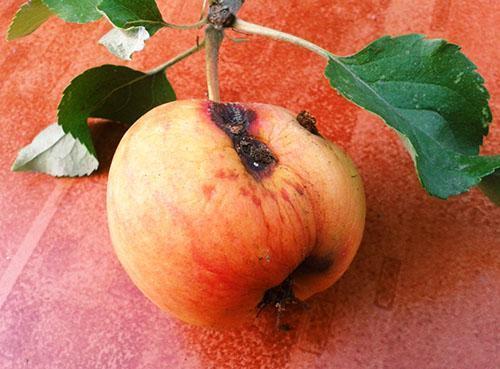Apple pest and disease control methods
 Abundant spring flowering and apple fruit ovary delights every gardener. But often, the closer it comes to harvesting, the less beautiful liquid fruits remain on the branches, and the tree itself takes on a sick appearance. A large number of diseases and pests interfere with the normal fruiting and ripening of fruits. A healthy crop can be obtained only with proper care and timely plant protection.
Abundant spring flowering and apple fruit ovary delights every gardener. But often, the closer it comes to harvesting, the less beautiful liquid fruits remain on the branches, and the tree itself takes on a sick appearance. A large number of diseases and pests interfere with the normal fruiting and ripening of fruits. A healthy crop can be obtained only with proper care and timely plant protection.
Photo of pests of apple trees and the fight against them
A huge number of insects love to feast on flowers, fruits and leaves of this tree. If you detect and correctly determine the type of pest in time, then the fight against it will not be as terrible as it is portrayed. Among the most dangerous pests for the garden, several species of aphids, ticks, moths and moths can be distinguished. The fight against each of them occurs from the beginning of budding to the ripening of the fruit.
How to defeat a moth

 The methods of dealing with the moth on an apple tree are quite diverse, and this whole process continues throughout the year:
The methods of dealing with the moth on an apple tree are quite diverse, and this whole process continues throughout the year:
- When a thaw occurs, it is necessary to clean the damaged bark in order to remove the cocoons hiding under it, after which the plant trunk should be whitewashed or treated with garden varnish. The same procedure must be carried out in late autumn.
- In May, special pheromone traps can be placed throughout the site that attract butterflies, which significantly reduces their population. To prepare the luring syrup, boil 100 g of dried apples (20-30 minutes) in 2 liters of water, and after the liquid has cooled to a temperature of 60-70 ° add sugar and yeast to it. Spread jars of syrup evenly throughout the garden.
- Collecting volunteers every day will prevent the caterpillars from leaving the fruit and continuing their destructive activities.
- In the period when insects emerge from eggs before they are introduced into apples (8-12 days after the peak summer of butterflies), it is recommended to carry out chemical treatment with special insecticides.
If you miss the spraying time and allow the penetration of the caterpillars into the fruits, then any further chemical or biological treatment will be meaningless. She will do more harm than good.
How to deal with aphids on an apple tree?
 This pest sucks juices from young leaves and shoots, as a result of which they bend, slow down in growth and completely dry out. Small insects of yellowish-green color, 1 - 3 mm in size, climb to the tops of the buds in the spring, and after they bloom, they penetrate inside, which greatly complicates the destruction of aphids.
This pest sucks juices from young leaves and shoots, as a result of which they bend, slow down in growth and completely dry out. Small insects of yellowish-green color, 1 - 3 mm in size, climb to the tops of the buds in the spring, and after they bloom, they penetrate inside, which greatly complicates the destruction of aphids.
Some predators ("ladybug", fly larvae or goose bumps) eat apple green aphids.Therefore, sometimes the beneficial insects present on the site are enough to fight the pest. Otherwise, trees will need to be sprayed with a variety of preparations. Spring treatment with 2% nitrafen emulsion (200 g of concentrate per 10 l of water) or phosphamide (10-15 g / 10 l of water) will help to exterminate the overwintering eggs of aphids.
The greatest concentration and activity of insects is usually observed at the beginning of summer. The following tips will show you how to deal with aphids on an apple tree in June. When a large number of pests appear, only spraying the crown will be effective. A good insecticidal property is a 12% hexachlorane dust or a 2% aqueous suspension of this preparation, as well as a soap solution (200-300 g / 10 l of water), which is used to wash the damaged areas.
Why do the leaves of the apple tree dry?
 Even the complete elimination of all pests does not guarantee a good healthy harvest. Trees also suffer from many diseases, as a result of which their leaves become covered with bloom or spots, and then curl, dry out and fall off. The most common diseases of the apple family are scab, powdery mildew and moniliosis (fruit rot).
Even the complete elimination of all pests does not guarantee a good healthy harvest. Trees also suffer from many diseases, as a result of which their leaves become covered with bloom or spots, and then curl, dry out and fall off. The most common diseases of the apple family are scab, powdery mildew and moniliosis (fruit rot).
Apple scab and methods of its treatment
 This type of disease is one of the most dangerous for many fruit trees and shrubs. Scab is a spore-bearing fungus that activates and multiplies when exposed to moisture. Initially, brown spots appear on the leaves of the apple tree, and over time, the fungus infects young shoots, flowers and unripe fruits.
This type of disease is one of the most dangerous for many fruit trees and shrubs. Scab is a spore-bearing fungus that activates and multiplies when exposed to moisture. Initially, brown spots appear on the leaves of the apple tree, and over time, the fungus infects young shoots, flowers and unripe fruits.
The main reason for the appearance of scab on an apple tree is excess moisture in the absence of ventilation in the crown. Therefore, the first preventive action is the spring pruning of excess branches and shoots. To combat scab, treatment with certain drugs should also be carried out:
- A solution based on urea (500-600 g / 10 l of water). Spraying of trees is carried out in early spring and autumn.
- Bordeaux liquid has an antifungal effect (300 g of lime and copper sulfate per 10 liters of water)
- Twice a year (before flowering and after fruit set), treatment with copper chloride should be carried out at the rate of 40 g per 10 liters of water.
Topaz and Hom received good reviews from many gardeners today. The first is sprayed before bud break, the second - immediately after flowering.
Powdery mildew
 Why leaves curl on an apple tree, not everyone knows. Many gardeners mistakenly attribute this to caterpillar activity. In fact, powdery mildew is the main cause of deformation. And caterpillars just populate ready-made "dwellings". The first signs of the disease are expressed by the appearance of an off-white or gray coating on the leaves. At the initial stage, it is easily erased, but becomes denser over time. The leaves on the apple tree curl, stop developing, turn yellow and die off.
Why leaves curl on an apple tree, not everyone knows. Many gardeners mistakenly attribute this to caterpillar activity. In fact, powdery mildew is the main cause of deformation. And caterpillars just populate ready-made "dwellings". The first signs of the disease are expressed by the appearance of an off-white or gray coating on the leaves. At the initial stage, it is easily erased, but becomes denser over time. The leaves on the apple tree curl, stop developing, turn yellow and die off.
Spraying colloidal sulfur will help get rid of apple diseases... The causative agent of powdery mildew "waits out" the winter in the buds of the tree, therefore the first treatment is recommended to be carried out simultaneously with their advance. Immediately after flowering, it is necessary to perform a second spraying, and after another two weeks - a third.
Moniliosis or fruit rot
 High humidity at high air temperatures contribute to the development of infection, in which rotting of fruits is observed directly on the branches. The causative agent of monoliosis is introduced into the fetus through the sites of damage by other diseases or pests. In such places, a small brown spot initially appears, and over time, rot covers the entire fruit. The development of infection will prevent spraying bordeaux liquid or a 3% suspension of copper chloride.
High humidity at high air temperatures contribute to the development of infection, in which rotting of fruits is observed directly on the branches. The causative agent of monoliosis is introduced into the fetus through the sites of damage by other diseases or pests. In such places, a small brown spot initially appears, and over time, rot covers the entire fruit. The development of infection will prevent spraying bordeaux liquid or a 3% suspension of copper chloride.
Important tips and tricks
Regardless of the type of damage to the tree, there are a number of recommendations that will help prevent insect populations and the development of any infections:
- Any infected parts of the crown should be trimmed and disposed of immediately.
- Damaged leaves, young shoots and fruits must be burned. Throwing them on a compost heap is highly undesirable.
- Wind, rain and insects contribute to the rapid spread of infections. Therefore, if signs of any lesions appear on one of the trees, a series of preventive actions should be taken throughout the garden.
- Spraying trees should be carried out in calm weather, observing a set of safety measures.
The use of chemical control agents during the period of fruit ripening is unsafe!
 Photos of pests and diseases of the apple tree will help to timely determine the nature and origin of the problem. However, it is better not to wait for its manifestation, but to carry out all preventive actions regularly throughout the year. After all, any ailment is much easier to prevent than to unsuccessfully fight it all your life. Read also the article: Why do apple leaves turn yellow in June?
Photos of pests and diseases of the apple tree will help to timely determine the nature and origin of the problem. However, it is better not to wait for its manifestation, but to carry out all preventive actions regularly throughout the year. After all, any ailment is much easier to prevent than to unsuccessfully fight it all your life. Read also the article: Why do apple leaves turn yellow in June?
About diseases and pests in such a concentrated form and so clearly there are almost no collections. In the summer, the summer resident does not have enough time to collect information, but here it is clearly shown, told and the recipe of the compositions is given. The video adds clarity and shows the methods of treating stem diseases. The only thing that raised doubts was the preparation based on dust. Perhaps I am mistaken and apologize in advance, but I heard that it is forbidden to use them on private households. Much attention has been paid to aphids. It really hurts all plants since spring and salvation is only to stop it before the leaf rolls into a tube. Inta-vir and similar drugs cope well with it. In general, as is clear from the article, if there is a garden, there will always be those who like to take away part of the harvest. The struggle for it is the main concern of the gardener. Big harvests for everyone!